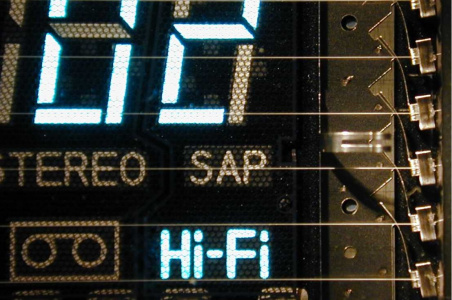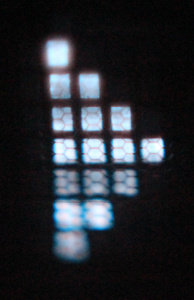Display types: Difference between revisions
| Line 297: | Line 297: | ||
{{stub}} | {{stub}} | ||
Small as in order of an inch. | Small as in order of an inch or two. | ||
| Line 305: | Line 304: | ||
call any small screen OLED if it means they sell more. | call any small screen OLED if it means they sell more. | ||
This is further made more confusing by the fact that there are few-color OLEDs (2 to 8 colors or so), | This is further made more confusing by the fact that there are | ||
so you sometimes need to dig into the tech specs to see the difference between high color LCD and high color OLED. | * few-color OLEDs (2 to 8 colors or so, great for high contrast but ''only'' high cotnrast), | ||
* [[high color][] OLEDs (65K), | |||
...so you sometimes need to dig into the tech specs to see the difference between high color LCD and high color OLED. | |||
<!-- | <!-- | ||
| Line 314: | Line 315: | ||
--> | --> | ||
When all pixels are off they give zero light pollution (unlike most LCDs) which might be nice in the dark. | When all pixels are off they give zero light pollution (unlike most LCDs) which might be nice in the dark. | ||
| Line 328: | Line 322: | ||
'''Video or not?''' | '''Video or not?''' | ||
These often don't connect video cables, but have their own controller. | These often don't connect video cables, but have their own controller, and their own video RAM. | ||
It matters that the lowish amount of pixels can be updated via an interface that is much less involved than a monitor - until you try to display video you might get reasonable results over SPI / I2C. | |||
There is a semi-standard parallel interface that might make video-speed things feasible. | |||
This interface is faster than the SPI/I2C option, though not always ''that'' much, depending on hardware details. | |||
Say, something like the {{imagesearch|tinycircuits tinytv|TinyTV}} runs a 216x135 65Kcolor display from a from a [[RP2040]]. | |||
Also note that such hardware won't be doing decoding and rescaling arbitrary video files. | |||
They will use specifically pre-converted video. | |||
If it ''does'' speak e.g. MIPI it's basically just a monitor -- but that amount of pixels also likely means you want something more RAM-heavy for a framebuffer, and more computationally heavy if you want to do something that looks remotely fancy at a speed you might call video. | |||
====Interfaces==== | ====Interfaces==== | ||
<!-- | <!-- | ||
* | * 4-line SPI | ||
* | * 3-line SPI ([[half duplex]], basically) | ||
* I2C | * I2C | ||
* 6800-series parallel | * 6800-series parallel | ||
* 8080-series parallel interface | * 8080-series parallel interface | ||
The last two are 8-bit parallel interfaces, the main | |||
The last two are 8-bit parallel interfaces, | |||
the main differences being the read/write and enable, and in timing. | |||
(they are references to Intel and Motorola origins of their specs{{verify}}) | |||
If they support both, 8080 seems preferable, in part because some only support that? | If they support both, 8080 seems preferable, in part because some only support that? | ||
Speed-wise, ''in theory'' parallel can be multiples faster, | Speed-wise, ''in theory'' parallel can be multiples faster, | ||
though notice that in some practice you are instead limited by the display's controller, and the difference may not even be twice (and bit-banging that parallel may take a lot more CPU than dedicated SPI). | though notice that in some practice you are instead limited by the display's controller, and the difference may not even be twice (and bit-banging that parallel may take a lot more CPU than dedicated SPI). | ||
There are others that aren't quite ''generic'' high speed moniutor interfaces yet, | |||
but too fast for slower hardware (e.g. CSI, MDDI) | |||
Revision as of 13:54, 8 March 2024
Backlit flat-panel displays
CCFL or LED backlight
https://nl.wikipedia.org/wiki/CCFL
Self-lit
OLED
QLED
On image persistence / burn-in
VFD
-
larger segments
-
dot matrix VFD
Vacuum Fluorescent Displays are vacuum tubes applied in a specific way - see Lightbulb_notes#VFDs for more details.
Lighting
Nixie tubes

Mechanical
Mechanical counter
https://en.wikipedia.org/wiki/Mechanical_counter
Split-flap

https://en.wikipedia.org/wiki/Split-flap_display
LED segments
7-segment and others

These are really just separate lights that happen to be arranged in a useful shape.
Very typically LEDs (with a common cathode or anode), though similar ideas are sometimes implemented in other display types - notably the electromechanical one, also sometimes VFD.
Even the simplest, 7-segment LED involves a bunch of connectors so are
- often driven multiplexed, so only one of them is on at a time.
- often done via a controller that handles that multiplexing for you
Seven segments are the minimal and classical case,
good enough to display numbers and so e.g. times, but not really for characters.
More-than-7-segment displays are preferred for that.
https://en.wikipedia.org/wiki/Seven-segment_display
DIY
LCD character dislays
Character displays are basically those with predefined (and occasionally rewritable) fonts.
Classical interface
The more barebones interface is often a 16 pin line with a pinout like
- Ground
- Vcc
- Contrast
- usually there's a (trim)pot from Vcc, or a resistor if it's fixed
- RS: Register Select (character or instruction)
- in instruction mode, it receives commands like 'clear display', 'move cursor',
- in character mode,
- RW: Read/Write
- tied to ground is write, which is usually the only thing you do
- ENable / clk (for writing)
- 8 data lines, but you can do most things over 4 of them
- backlight Vcc
- Backlight gnd
The minimal, write-only setup is:
- tie RW to ground
- connect RS, EN, D7, D6, D5, and D4 to digital outs
I2C and other
Matrix displays
Small LCD/TFTs / OLEDs
Small as in order of an inch or two.
Note that, like with monitors, marketers really don't mind if you confuse backlit LCD with OLED,
and some of the ebays and aliexpresses sellers of the world will happily 'accidentally'
call any small screen OLED if it means they sell more.
This is further made more confusing by the fact that there are
- few-color OLEDs (2 to 8 colors or so, great for high contrast but only high cotnrast),
- [[high color][] OLEDs (65K),
...so you sometimes need to dig into the tech specs to see the difference between high color LCD and high color OLED.
When all pixels are off they give zero light pollution (unlike most LCDs) which might be nice in the dark. These seem to appear in smaller sizes than small LCDs, so are great as compact indicators.
Video or not?
These often don't connect video cables, but have their own controller, and their own video RAM.
It matters that the lowish amount of pixels can be updated via an interface that is much less involved than a monitor - until you try to display video you might get reasonable results over SPI / I2C.
There is a semi-standard parallel interface that might make video-speed things feasible. This interface is faster than the SPI/I2C option, though not always that much, depending on hardware details.
Say, something like the TinyTV runs a 216x135 65Kcolor display from a from a RP2040.
Also note that such hardware won't be doing decoding and rescaling arbitrary video files. They will use specifically pre-converted video.
If it does speak e.g. MIPI it's basically just a monitor -- but that amount of pixels also likely means you want something more RAM-heavy for a framebuffer, and more computationally heavy if you want to do something that looks remotely fancy at a speed you might call video.
Interfaces
ST7735
LCD, 132x162@16bits RGB
ST7789
LCD, 240x320@16bits RGB
https://www.waveshare.com/w/upload/a/ae/ST7789_Datasheet.pdf
SSD1331
OLED, 16bits RGB https://cdn-shop.adafruit.com/datasheets/SSD1331_1.2.pdf
SSD1351
OLED, 65K color
https://newhavendisplay.com/content/app_notes/SSD1351.pdf
HX8352C
https://www.ramtex.dk/display-controller-driver/rgb/hx8352.htm
ILI9163
LCD, 162x132@16-bit RGB
http://www.hpinfotech.ro/ILI9163.pdf
ILI9341
https://cdn-shop.adafruit.com/datasheets/ILI9341.pdf
ILI9486
LCD, 480x320@16-bit RGB
https://www.hpinfotech.ro/ILI9486.pdf
ILI9488
LCD
https://www.hpinfotech.ro/ILI9488.pdf
PCF8833
LCD, 132×132 16-bit RGB
https://www.olimex.com/Products/Modules/LCD/MOD-LCD6610/resources/PCF8833.pdf
SEPS225
LCD
https://vfdclock.jimdofree.com/app/download/7279155568/SEPS225.pdf
(near-)monochrome
SSD1306
OLED, 128x64@4 colorsTemplate:Vierfy
https://cdn-shop.adafruit.com/datasheets/SSD1306.pdf
SH1107
OLED,
https://datasheetspdf.com/pdf-file/1481276/SINOWEALTH/SH1107/1
Round
GC9A01
backlit LCD, 65K colors, SPI

